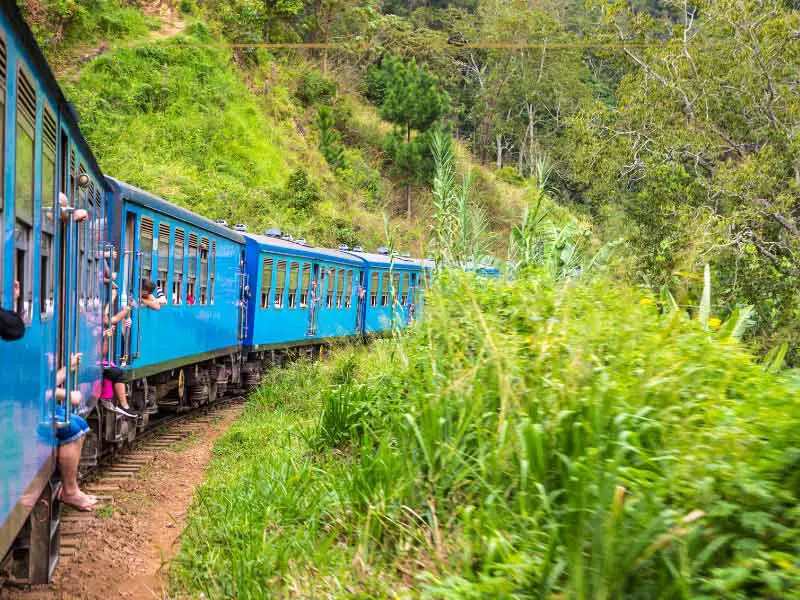In an alarming incident that highlights the growing dangers of extreme photo-taking behavior among travelers, a 35-year-old tourist suffered critical injuries when she leaned out of a moving train in Sri Lanka and collided with a tunnel wall. The incident occurred during what should have been a scenic journey through the picturesque central highlands of the country, transforming a vacation highlight into a cautionary tale about prioritizing safety over social media content.

Dangerous Photo Attempt Leads to Hospitalization
The tourist, traveling on the popular mountain route from Nanu Oya to Badulla on March 9, was reportedly attempting to capture scenic photographs by extending her body outside the moving train when disaster struck. As the train entered a tunnel, she suffered a devastating impact with the tunnel wall, resulting in severe head and leg trauma that required immediate medical attention.
First responders transported the injured woman to Haputale Regional Hospital, where medical staff stabilized her condition before transferring her to specialized facilities better equipped to handle the severity of her injuries. Hospital officials have not released details about her current condition, but sources indicate she remains under intensive care.
The incident prompted the Chinese Embassy in Sri Lanka to issue an urgent advisory on its website the following day, emphasizing the importance of train safety. The statement specifically warned travelers to maintain a safe distance from train doors and refrain from leaning out of moving vehicles for photographs.
A Troubling Pattern of Risk-Taking
This accident represents just one instance in a disturbing trend of tourists engaging in dangerous behaviors while pursuing dramatic photographs in Sri Lanka. The mountainous rail routes, with their breathtaking views of tea plantations and valleys, have become particularly popular for such risky photographic endeavors.
According to regional tourism experts, the specific photo pose that led to this tragedy has gained popularity on social media platforms, where images of travelers leaning perilously from train doorways against scenic backdrops receive substantial engagement. Many visitors arrive in Sri Lanka with these specific images in mind, determined to recreate them regardless of the evident dangers.
Local tour operators have noted a marked increase in tourists requesting information about the best locations for these types of photographs. One guide explained that many travelers now specifically book certain train routes not for the journey itself but for the photo opportunities they present.
“We’ve seen a complete shift in motivations,” a tourism industry veteran explained. “Many visitors are now more concerned with documenting their experiences for social media than actually experiencing the country. This focus on photography rather than personal safety has created dangerous situations across our rail network.”
A History of Similar Incidents
Alarmingly, this recent accident is not an isolated case. Sri Lanka has witnessed several comparable incidents involving tourists taking risks for photographs on its iconic railway lines.
In February of this year, a 53-year-old Russian tourist lost her life in similar circumstances while attempting to capture a selfie while hanging from a footboard on the Podi Menike rail line. After colliding with a trackside rock, she fell from the moving train and sustained fatal injuries.
December witnessed two additional incidents. A Chinese tourist suffered minor injuries after leaning her upper body out of a moving train to film video content and being struck by tree branches. That same month, an Iranian woman sustained critical head injuries in nearly identical circumstances to the most recent case—leaning out of a train door and hitting a tunnel wall near the Ohiya and Idalgashinna section of track.
These recurring accidents demonstrate a pattern that railway officials and tourism authorities are struggling to address effectively. Despite warning signs, verbal cautions from railway staff, and publicity surrounding previous incidents, travelers continue to engage in these high-risk behaviors.
The Rise of “Selfie Tourism”
The incident has reignited discussions about “selfie tourism,” a phenomenon where travelers prioritize photographic documentation of themselves at destinations over cultural immersion or authentic experiences. This trend, which has grown exponentially with the rise of image-based social media platforms, has transformed how many approach international travel.
Cultural heritage experts and tourism researchers have expressed concern about this shift in travel motivation. UNESCO has specifically criticized the trend, noting that it often leads to superficial engagement with cultural sites and potential disrespect for local customs and traditions.
Beyond the obvious physical risks demonstrated by this latest incident, selfie tourism has contributed to other problems at popular destinations worldwide. Historic landmarks face unprecedented crowding as visitors queue for the perfect photo opportunity, while local infrastructure strains under the pressure of tourism traffic concentrated in photogenic locations rather than distributed throughout regions.
Environmental impacts have also been documented, with travelers sometimes venturing off designated paths or disturbing sensitive ecosystems to capture unique perspectives. In some instances, wildlife has been disturbed or endangered by photo-seeking tourists.
Social Media Response and Public Reaction
News of the accident spread rapidly across social media platforms, generating significant debate about responsible travel behavior. Many users expressed sympathy for the injured tourist while emphasizing the importance of prioritizing safety over social media content.
One travel blogger reflected on a similar risk they had once taken: “I once attempted the same thing, leaning out for what I thought would be a once-in-a-lifetime photograph. Looking back now, I realize how foolish that decision was and how differently things could have ended.”
Others questioned the underlying motivations driving such behavior. “We need to ask ourselves what the purpose of travel truly is,” wrote one commenter. “Are we traveling to genuinely experience different cultures and landscapes, or simply to document ourselves in these places for social approval?”
Some responses were less sympathetic, describing the incident as an inevitable consequence of reckless behavior. Terms like “social Darwinism” appeared in discussions, prompting pushback from those who felt such characterizations were insensitive given the serious injuries sustained by the tourist.
The debate highlights the complex relationship many travelers now have with risk assessment when photography is involved. Studies suggest that the prospect of an exceptional photograph can significantly alter risk perception, with individuals willing to accept dangers they would otherwise avoid.
The Scientific Study of Selfie-Related Incidents
The growing frequency of accidents related to photography has prompted academic research into the phenomenon. A comprehensive study published by the National Library of Medicine examined 259 selfie-related fatalities that occurred globally between October 2011 and November 2017.
The research identified several common scenarios in these incidents, with falls from height, drowning, and transportation-related accidents representing the most frequent categories. India reported the highest number of such fatalities, followed by Russia, the United States, and Pakistan.
A more recent analysis published in the Journal of Travel Medicine expanded this data, documenting 379 deaths related to selfie-taking between January 2008 and July 2021. Perhaps most concerning was the finding that the average age of victims was just 24.4 years, suggesting that younger travelers may be particularly susceptible to underestimating risks when pursuing dramatic photographs.
The authors of both studies recommended the establishment of “no selfie zones” in dangerous locations such as cliff edges, mountain peaks, tall buildings, and bodies of water. Some tourist destinations have already implemented such restrictions, though enforcement remains challenging.
Railway Safety Measures and Tourism Industry Response
In response to the pattern of accidents, Sri Lankan railway authorities have begun implementing additional safety measures on popular tourist routes. These include increased signage warning of the dangers of leaning out of trains, more frequent safety announcements during journeys, and in some cases, the installation of additional barriers at train doorways.
The tourism industry has also responded by developing alternatives for photography enthusiasts. One such initiative is the promotion of the Calypso train, a slower service specifically designed to allow for safer photography. The reduced speed provides opportunities for photographs while minimizing the risks associated with high-speed travel.
Tour companies have begun emphasizing responsible photography in their pre-departure materials and guide briefings. Some have gone further by refusing to assist with or encourage dangerous photo attempts, even when specifically requested by clients.
Industry associations have called for a coordinated approach to addressing the issue, including standardized safety briefings, educational campaigns targeting international visitors before arrival, and cooperation with social media platforms to reduce the visibility of content depicting dangerous behaviors.
The Psychology Behind Risky Photography
Psychologists studying this phenomenon point to several factors that may contribute to tourists’ willingness to take risks for photographs. Social validation through likes and comments serves as a powerful motivator, creating a reward system that can override normal risk assessment processes.
The temporary nature of tourism may also play a role, with travelers perceiving their visit as a “once-in-a-lifetime” opportunity that justifies exceptional behaviors they would avoid in everyday life. This perception of scarcity—that they may never return to capture the image—can lead to impulsive decisions.
Additionally, the prevalence of similar images on social media creates a normalization effect. When travelers repeatedly see photographs of others leaning from trains or standing near cliff edges, these behaviors begin to seem standard and acceptable rather than extraordinary and dangerous.
Social comparison theory suggests that individuals may feel pressure to match or exceed the experiences documented by their peers, leading to an escalation of risk-taking over time as more extreme photographs gain prominence.
Looking Beyond the Perfect Shot
Tourism experts emphasize that meaningful travel experiences extend far beyond photographic documentation. Sri Lanka, with its rich cultural heritage, diverse ecosystems, and welcoming communities, offers countless opportunities for authentic engagement that don’t involve physical risk.
“The true beauty of travel lies in the connections we form, the perspectives we gain, and the memories we create through genuine experiences,” one sustainable tourism advocate noted. “A photograph can capture a moment, but it cannot substitute for the full sensory and emotional experience of being present in a place.”
For those determined to capture striking images during rail journeys through Sri Lanka’s highlands, safer alternatives exist. Designated photography stops along scenic routes allow for dramatic landscapes to be captured without risk. Professional photography tours with experienced guides can provide access to spectacular vantage points while ensuring appropriate safety measures.
A Global Perspective on Tourism Safety
This incident in Sri Lanka reflects broader concerns about tourism safety worldwide. As destinations become more accessible and social media continues to influence travel behaviors, similar patterns have emerged across continents.
In Norway, authorities have installed barriers and warning signs at popular fjord viewpoints following several fatal accidents involving photo-taking tourists. Peru’s Machu Picchu has implemented strict visitor paths and time limits after dangerous overcrowding driven partly by photography. In Croatia, Dubrovnik has established designated selfie spots to direct visitors away from precarious positions on the ancient city walls.
These measures represent attempts to balance the legitimate desire of tourists to document their experiences with the fundamental responsibility of ensuring visitor safety. The challenge lies in preserving the sense of adventure and discovery that makes travel meaningful while preventing unnecessary tragedies.
Responsible Travel in the Digital Age
As this recent incident fades from headlines, tourism stakeholders hope it will contribute to a broader conversation about responsible travel in an era dominated by social media. The discussion extends beyond physical safety to encompass respect for local communities, environmental sustainability, and the quality of the travel experience itself.
For individual travelers, the incident serves as a powerful reminder to question motivations and reassess priorities. The most meaningful souvenirs rarely come in the form of photographs, no matter how dramatic or well-composed.
Travel industry professionals suggest several principles for responsible photography: never compromise safety for a photograph; respect local customs, privacy, and regulations; consider the environmental impact of pursuing certain images; and remember that the primary purpose of travel is the experience itself, not its documentation.
As one travel writer eloquently stated: “The best travel photographs capture moments of genuine connection and discovery. These emerge naturally from mindful travel rather than from manufactured moments that prioritize appearance over authenticity. No photograph is worth risking your life, or diminishing the depth of your experience.”
This latest accident in Sri Lanka stands as a sobering reminder of what can be lost when the pursuit of the perfect image overshadows the fundamental joys and responsibilities of exploring our world.




